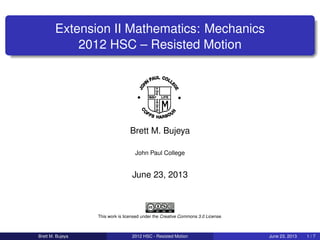2012 Extension 2 Resisted Motion
- 1. Extension II Mathematics: Mechanics 2012 HSC ŌĆō Resisted Motion Brett M. Bujeya John Paul College June 23, 2013 This work is licensed under the Creative Commons 3.0 License. Brett M. Bujeya 2012 HSC - Resisted Motion June 23, 2013 1 / 7
- 2. 2012 HSC, Question 13Question 13 (15 marks) Use a SEPARATE writing booklet. (a) An object on the surface of a liquid is released at time t = 0 and immediately sinks. Let x be its displacement in metres in a downward direction from the surface at time t seconds. The equation of motion is given by 2 dv v = 10 ŌłÆ , dt 40 where v is the velocity of the object. (i) (ii) (iii) t 20 e ŌłÆ 1( )Show that v = .t e + 1 dv dv ŌÄø 400 Use = v to show that x = 20logedt dx ŌÄØŌÄ£ 400 ŌłÆ v How far does the object sink in the first 4 seconds? ŌÄ× ŌÄĀŌĤ . 4 2 2 2 Brett M. Bujeya 2012 HSC - Resisted Motion June 23, 2013 2 / 7
- 3. 2012 HSC, Question 13(i) ŌĆō Solution dv dt = 10 ŌłÆ v2 40 dv dt = 400 ŌłÆ v2 40 40 v 0 dv 400 ŌłÆ v2 = t 0 dt Using partial fractions, 40 dv 400 ŌłÆ v2 = 40 dv (20 + v)(20 ŌłÆ v) = 1 20 + v + 1 20 ŌłÆ v dv Ōł┤ t 0 dt = v 0 1 20 + v + 1 20 ŌłÆ v dv t = ln 20 + v 20 ŌłÆ v v 0 Ōł┤ t = ln 20 + v 20 ŌłÆ v et = 20 + v 20 ŌłÆ v 20(et ŌłÆ 1) = v(1 + et ) v = 20(et ŌłÆ 1) 1 + et Brett M. Bujeya 2012 HSC - Resisted Motion June 23, 2013 3 / 7
- 4. 2012 HSC, Question 13(ii) ŌĆō Solution v dv dx = 10 ŌłÆ v2 40 v dv dx = 400 ŌłÆ v2 40 x 0 dx = 40 v 0 v 400 ŌłÆ v2 dv x = ŌłÆ20 ln(400 ŌłÆ v2 ) v 0 x = ŌłÆ20 ln 400 ŌłÆ v2 400 Ōł┤ x = 20 ln 400 400 ŌłÆ v2 Brett M. Bujeya 2012 HSC - Resisted Motion June 23, 2013 4 / 7
- 5. 2012 HSC, Question 13(iii) ŌĆō Solution When t = 0, v = 0 and x = 0 When t = 4, v = 20(e4 ŌłÆ 1) e4 + 1 and x = 20 ln ’Ż½ ’ŻŁ 400 400 ŌłÆ 400(e4ŌłÆ1)2 (e4+1)2 ’ŻČ ’ŻĖ = 20 ln e4 + 1 2 4e4 Hence, the particle moves 20 ln e4 + 1 2 4e4 metres in the ’¼ürst 4 seconds. Brett M. Bujeya 2012 HSC - Resisted Motion June 23, 2013 5 / 7
- 6. Notes From the Marking Centre I i. In better responses, after ’¼ünding the expression dt dv = 40 400 ŌłÆ v2 , candidates used partial fractions and correct integration to obtain t = ln 20 + v 20 ŌłÆ v . In better responses, candidates demonstrated their competency by changing the subject to obtain the required expression for v. In weaker responses, some candidates attempted to use the result for dx a2 ŌłÆ x2 without resorting to partial fractions. In many of these responses, candidates did not obtain the correct result of this integration. ii. Having obtained dx dv = 40v 400 ŌłÆ v2 , the majority of candidates handled this part well and obtained the required result. Brett M. Bujeya 2012 HSC - Resisted Motion June 23, 2013 6 / 7
- 7. Notes From the Marking Centre II iii. This part was again well done. The most successful approach was to substitute t = 4 into v = 20(et ŌłÆ 1) et + 1 and then substitute this expression into x = 20 ln 400 400 ŌłÆ v2 . Another approach was to integrate using dx dt = 20(et ŌłÆ 1) et + 1 . Only a small number of candidates used this approach, and of them very few successfully obtained the required result. Brett M. Bujeya 2012 HSC - Resisted Motion June 23, 2013 7 / 7







